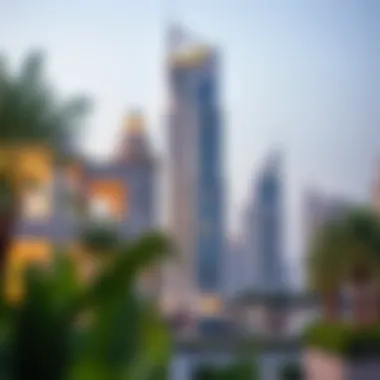Understanding Dubai's Green List in Real Estate


Intro
Navigating the real estate market in Dubai can feel like traversing a dense jungle, filled with opportunities and challenges awaiting discovery. At the heart of this lies the Green List, an essential tool for investors, agents, and expats looking to make informed decisions. The significance of this list cannot be overstated, as it demystifies property eligibility criteria while highlighting the kind of opportunities ripe for the picking.
The Green List serves as a critical framework for anyone involved in the real estate sector in Dubai, offering insight into which properties are eligible for investment and which areas present the best possibilities. For stakeholders, understanding this list is key to effectively maneuvering through the complexities of the market. In this article, we will dive deep into the implications of the Green List on Dubai's real estate landscape and what it means for both investors and renters.
Market Trends
Current Market Analysis
Dubai's real estate market has witnessed considerable shifts over recent years. The advent of the Green List has further shaped current market dynamics. A notable trend is the increasing appeal of mixed-use developments. These properties, often found in key areas like Dubai Marina and Downtown Dubai, provide versatile living and working spaces. Coupled with attractive financing options, such developments are winning hearts and wallets alike.
The Green List encourages investment by promoting properties that meet stringent criteria for quality, sustainability, and community benefits.
This doesn’t just enhance investor confidence but also drives demand up across certain sectors, particularly within luxury and upscale hospitality properties. Investors are now more inclined towards assets that not only promise high returns but also align with sustainable practices.
Future Predictions
Looking ahead, the trend toward sustainability and smart investments will likely dominate the landscape. Analysts predict that as more properties qualify for the Green List, an increase in the overall quality of available inventory is on the horizon. Additionally, you could expect a surge in interest from foreign investors, driven by the attractive lifestyle Dubai offers.
Expanding infrastructure projects, like the proposed metro lines and new cultural hubs, are set to enhance connectivity and accessibility—further boosting property values. With this backdrop, investors positioning themselves wisely in anticipation of these developments will undoubtedly glean the benefits.
Property Investment Insights
Types of Investment Properties
Investors should familiarize themselves with various property types to effectively leverage the Green List framework. Here are some noteworthy categories:
- Residential properties: These include apartments and villas located in prominent areas known for their lifestyle offerings.
- Commercial properties: Perfect for businesses looking to establish themselves, these spaces often yield substantial returns.
- Mixed-use properties: These developments combine residential and commercial spaces, offering a balanced investment option.
Financing Options and Tips
Understanding financing options can be a game changer when investing in Dubai's real estate. Many banks and financial institutions offer competitive loan packages that cater specifically to expatriates. Here are a few tips to keep in mind:
- Research thoroughly: Look into various banks to find the best interest rates and structures.
- Pre-approval: Securing a mortgage pre-approval can strengthen your position when making offers.
- Leverage expertise: Working with a reputable real estate agent who understands the intricacies of the Green List can help identify the best financing strategies.
Foreword to the Green List in Dubai
The Green List in Dubai serves as a pivotal guide in the realm of real estate, setting the stage for how investments and property ownership are structured in this vibrant market. The relevance of this concept cannot be overstated, particularly for investors, expats, agents, and anyone keen on navigating the complexities of property in Dubai. The Green List isn't just some bureaucratic checklist; it's a comprehensive framework that highlights which properties meet specific sustainability and regulatory standards.
As the global focus shrinks towards sustainable living, Dubai’s Green List aligns with these trends by promoting responsible real estate practices. This list brings to light various benefits, including promoting transparency within the industry and possibly enhancing the value of compliant properties. Understanding this list is essential as it not only impacts potential returns on investments but can also affect rental prices and accessibility for a growing expatriate community.
When discussing the Green List, one must consider the considerations and applications relevant to various stakeholders in the market. Be it the first-time buyer eyeing an apartment in Downtown Dubai or large-scale investors assessing multi-million developments, the implications of the Green List resonate through all levels of engagement in the real estate sector.
"The Green List isn't just about compliance; it's about creating a better investment environment through sustainability and transparency."
In the sections below, we will explore the intricacies of the Green List further, digging into its definition and purpose, alongside an exploration of its historical context in Dubai’s ever-evolving real estate landscape.
Definition and Purpose
The Green List in Dubai is essentially a catalogue that identifies properties meeting certain criteria aimed at promoting sustainability and environmentally-friendly practices. Its purpose extends beyond mere classification; it is designed to help stakeholders make informed decisions on property purchases and investments based on a set of standardized metrics.
Primarily, this list was created to enhance awareness and push for eco-friendly building practices. By highlighting properties that have adopted sustainable technologies or materials, the Green List also serves as a promotional tool for environmentally responsible developers. This creates a ripple effect, encouraging other builders to adopt green strategies to remain competitive.
In addition, the presence of a Green List means buyers can identify properties that offer a certain degree of assurance regarding environmental impact and long-term viability. Expecting high returns, investors can feel more secure knowing they’re aligning with global standards focusing on sustainability.


Historical Context
To understand the significance of the Green List today, we need to take a brief stroll down memory lane. Dubai’s rapid evolution into a global hub for trade and tourism was often marked by hastily developed infrastructure, where the focus was more on speed than sustainability. However, as awareness of environmental challenges grew, the necessity for more sustainable practices gained traction.
The concept of the Green List emerged as a response to these challenges. Originating from international frameworks like LEED (Leadership in Energy and Environmental Design), the Dubai Green List was established to set a locally adapted standard that reflects the unique attributes of the city.
The introduction of the Green List marked a turning point, as it not only focused on elevating environmental standards but also aimed to enhance the real estate market's appeal at an international level.
Over the years, the tightening of regulations has spurred growth in sectors dedicated to sustainable construction, thus shifting the narrative towards balancing innovation with responsibility. This framework continues to evolve, making it crucial for every stakeholder within the real estate market to stay informed about changes.
In the following sections, we will delve deeper into how the criteria for listings are established, the types of properties included in this list, and what it means for investors and renters alike.
The Criteria of the Green List
Understanding the criteria of the Green List is crucial for anyone participating in Dubai's real estate scene. This framework shapes investment decisions, influences rental pricing, and ultimately determines the viability of various property kinds on the market. Recognizing these criteria not only aids investors and renters in making informed choices but also lays the groundwork for anticipating market dynamics.
Regulatory Guidelines
The regulatory guidelines forming the backbone of the Green List cannot be overlooked. These rules emanate from governmental bodies, designed to ensure a standardized approach to property evaluations. For instance, properties must adhere to specific building codes and sustainability requirements before being added to the Green List. It creates a level playing field, fostering fair competition among developers and minimizing risks associated with unregulated properties.
An important aspect here is the role of local authorities in periodically revising these guidelines. As urban planning evolves, so do the requirements. This means that what might qualify one year could be reconsidered the next. Investors who keep an eye on these changing regulations can position themselves more favorably in the market.
- "Understanding regulatory guidelines is not just about compliance; it’s about leveraging opportunity."
Types of Properties Included
Next on the agenda is the assortment of property types that find themselves within the Green List's embrace. These can range from residential villas to commercial office spaces and even mixed-use developments. What stands out is the inclusion of eco-friendly designs, reflecting a larger shift towards sustainability in urban development. For investors and potential buyers, this factors into decision-making processes, as these properties not only promise compliance with current guidelines but are also seen as forward-thinking investments.
Several notable examples include luxury apartments in Marina Bay, which boast energy-efficient systems, and commercial spaces like office towers equipped with smart technologies. With the government pushing for a greener approach, properties fitting this mould can expect higher demand and potentially increased rental income due to the positive perception surrounding them.
Role of Sustainability Metrics
The role that sustainability metrics play within the Green List is a lens through which the future is viewed. These metrics point to how a property performs in terms of energy use, water conservation, and resource management. Not just a checkbox for compliance, they operationalize the concept of sustainability into tangible outcomes.
When evaluating a property for inclusion, metrics like LEED (Leadership in Energy and Environmental Design) certification are taken into account. This adds a layer of legitimacy, showing that a property has been assessed on its environmental impact, making it more appealing to environmentally conscious investors and renters alike.
In summary, the criteria revolving around the Green List not only serve as a guideline for properties but also reflect broader market trends, setting the stage for investor confidence and long-term sustainability in Dubai's real estate market.
Implications for Investors
When diving into Dubai's real estate market, understanding the Green List is crucial for discerning investors. The Green List doesn't just categorize properties but serves as a beacon for investment opportunities that align with the principles of sustainability and regulatory compliance. Investors need to take note of how this framework can shape their approach to investment in terms of returns, risks, and even future market trends.
Understanding Investment Returns
Investment returns in Dubai can be rather enticing, but they often come with a notable caveat: not all properties yield the same potential for profits. By focusing on properties within the Green List, investors find themselves in a advantageous position. Properties on this list tend to attract a more conscientious demographic, increasing the likelihood of steady rental income. The alignment with the government's sustainability goals also enhances the marketability of these properties. In essence, here’s what you need to consider:
- Higher Demand: As sustainability becomes more critical for tenants, properties that comply with the Green List are likely to see increased demand. This can lead to higher rental rates.
- Stable Investments: Properties that meet these sustainability standards often enjoy lower vacancy rates, providing more dependable cash flow.
- Potential for Value Appreciation: The trend towards eco-friendly living is not a passing fad—properties that are Green List compliant may appreciate faster over time than non-compliant ones.
Understanding these dynamics can significantly assist investors in making informed choices.
Risk Assessment
Diving into the waves of investment can be daunting, especially in a market like Dubai's, known for its rapid changes. Risk assessment is vital for investors and involves not only the financial implications but also the environmental and regulatory risks associated with real estate. Adhering to the Green List can alleviate several risks:


- Regulatory Compliance Risks: Properties that meet Green List criteria are usually in line with current regulations, reducing the risk of unforeseen costs related to non-compliance.
- Market Risk: Sustainability is at the forefront of global trends. As tenants and buyers show a growing preference for eco-friendly options, properties on the Green List may face less risk during market downturns.
- Physical Risks: Properties with sustainable features often employ designs that are resilient to climate-related issues, potentially lowering maintenance costs for investors.
To navigate the ever-changing real estate landscape efficiently, investors should continuously evaluate their risk posture.
Long-term Market Trends
The trajectory of Dubai’s real estate market is heavily influenced by evolving trends. The Green List is likely a key player that shapes these trends moving forward. Several long-term implications stand out:
- Increased Competition: As more investors realize the benefits of the Green List, competition for these properties will likely heat up. Staying ahead in this realm could be critical.
- Integration of Technology: Properties that meet sustainability benchmarks often incorporate modern technologies, enhancing their appeal. The real estate market is starting to trend towards smart buildings that offer energy efficiency and lower operating costs.
- Shift in Buyer Demographics: Besides investors, primary buyers are increasingly younger generations that prioritize sustainability. These shifts can drive significant changes in property desirability over time.
As the market evolves, investors should remain vigilant, adapting their strategies to capitalize on the long-term trends introduced by the Green List.
Benefits for Renters
Renters in Dubai have an interesting opportunity with the Green List, as it influences not only their living conditions but also the overall rental ecosystem. This section dives into how the Green List shapes the rental landscape, offering valuable insights for those looking to make informed choices.
Informed Decision Making
The Green List serves as a beacon for renters. It helps them distinguish properties that are not only sustainable but also compliant with Dubai's regulations. This information is paramount for anyone looking to lease a home in a city where options can be overwhelming. Knowing which properties are on the Green List can empower renters to make smarter choices.
- Transparency: The criteria for inclusion in the Green List means that renters can expect a certain standard of living. Properties that qualify often have better amenities, energy efficiency, and adherence to environmental norms.
- Security: Many renters feel unsure about their rights and the quality of their rented space. The Green List offers comfort; properties listed are regularly assessed, minimizing risks related to unsafe or poorly maintained housing.
- Community Benefits: Living in a Green List property often means becoming part of a community focused on sustainability. This can enhance the living experience, as renters share values with their neighbors, fostering a more cohesive environment.
Overall, having this list equips renters with the necessary knowledge to navigate the real estate market in Dubai, saving them from potential pitfalls.
Understanding Rental Pricing
In the ever-evolving rental market, understanding pricing is crucial for renters wanting to get the most value for their money. The Green List affects rental pricing in a few significant ways.
- Value Assessment: Properties on the Green List might carry a premium, but this is often justified. Renters are paying for quality, better maintenance, and energy efficiency. Additionally, these residences are usually in desirable locations, contributing to a higher but fair rental price.
- Market Stability: The Green List impacts the overall rental market by encouraging landlords to invest in better property maintenance and sustainable practices. This stability can help prevent sudden rental spikes, providing a more predictable rental experience for tenants.
"In a changing market, informed renters are empowered renters."
- Negotiation Leverage: Armed with knowledge from the Green List, tenants can negotiate better terms. Understanding what constitutes a fair rental price versus a listing inflated due to non-sustainable factors allows them to advocate effectively for their interests.
In summary, the Green List not only guides renters in making educated decisions but also sheds light on rental pricing dynamics. By grasping these aspects, individuals can navigate their options more efficiently and secure accommodations that meet their needs and expectations.
Impact on the Broader Economy
The Green List's significance extends well beyond the realms of property transactions and rental agreements. It plays a pivotal role in shaping the overall economic landscape of Dubai, influencing investment patterns, external perceptions, and long-term viability of the real estate market. Not only does this initiative aim to enhance sustainability within real estate, but it also serves as a metric of economic growth and stability that can be attractive to foreign investors and national stakeholders alike.
Real Estate Market Dynamics
In understanding how the Green List impacts real estate market dynamics, one must consider its contribution to the regulatory framework. By providing a structured and regulated list of properties that meet certain sustainability standards, it fosters consumer trust. When investors see that their potential investments align with the Green List criteria, they are more likely to engage, fueling a cycle of increased activity in the market.
Additionally, the Green List has implications for property values. Properties on this list often fetch higher prices—not just for their sustainable features but for the confidence that they represent. Increased demand leads to price appreciation, benefitting priors and traders alike. This uptick in value can stimulate construction, leading to more jobs and a bustling real estate sector, which benefits the broader economy as spending increases.
Factors influencing this property surge can be complex. Economic indicators, regional stability, and global trends often coalesce. For instance, a rise in tourism may enhance rental incomes and revitalize interest in sustainable properties, due to the attractions of eco-conscious development.
Sustainability Initiatives
Sustainability initiatives that flow from the Green List are not just buzzwords. They are rooted in the real commitment to addressing pressing environmental concerns and urban resilience, critical for the future of Dubai. By prioritizing properties that exhibit eco-friendly features—such as energy-efficient systems, sustainable materials, and green spaces—the Green List contributes towards reducing the ecological footprint of urban development.
Several government programs further enhance this commitment. For instance, Dubai’s 2040 Urban Master Plan emphasizes sustainability, indicating a long-term vision that aligns with global environmental goals. Aspects such as green building certifications and renewable energy projects fit snugly within this framework, encouraging developers to prioritize these elements in their projects.
Moreover, through various partnerships with international organizations, Dubai aligns itself with global sustainability standards that resonate with environmentally conscious investors. These partnerships amplify the city’s reputation and attract international attention to its real estate market. As these initiatives gain traction, they will inevitably have a spillover effect on other sectors—leading to a more diversified and resilient economy.
The integration of sustainability metrics into investment strategies signals a forward-thinking approach that can attract capital to the region, further solidifying Dubai’s place on the world stage.


The Future of the Green List
The anticipation surrounding the future of the Green List in Dubai's real estate market is palpable. Investors, agents, and stakeholders in the economy are all tuned into the developments of this framework. As the world shifts towards sustainability, the Green List stands at a crucial intersection of economic opportunity and environmental responsibility. It aims not just to promote certain properties but to elevate the entire market.
The importance of discussing the future of the Green List lies in its potential to evolve with changing regulations and market demands. As Dubai positions itself as a global hub, maintaining alignment with international standards is essential. Here, we explore two key aspects that will shape the future landscape of the Green List: potential revisions and updates, and its alignment with global standards.
Potential Revisions and Updates
As the saying goes, "What got you here won't get you there," and this perfectly encapsulates the essence of the Green List. The criteria that once deemed properties eligible for inclusion may soon see an overhaul to better reflect the continuous advancements in technology and sustainability practices.
- Incorporating Advanced Sustainability Metrics
Investors today crave not just returns but also conscientious investments. There's a growing appetite for metrics that address carbon footprints, energy efficiency, and water conservation. Envision a potential future where properties are evaluated based on life cycle assessments, offering a holistic view of their environmental impact. - Feedback from Stakeholders
Real estate is rarely a one-size-fits-all endeavor. Extending channels for feedback from investors, tenants, and even environment-focused organizations could inform updates to the Green List. This dynamic process of revision might lead to more tailored property inclusions. - Adapting to Economic Changes
The world is unpredictable; economic cycles influence property values and investment interest. Thus, the Green List might need an agile approach to adapt to these shifts. Whether it's integrating more budget-friendly options or adjusting requirements in response to economic downturns, adaptability will be key.
Aligning with Global Standards
In a sinuous global economy, aligning the Green List with international benchmarks is no longer optional; it’s a necessity. Countries worldwide are bidding to lead the charge in sustainable development, and Dubai must position itself as a contender in this arena.
The alignment can take several forms:
- Certification Compatibility
To encourage foreign investments, the Green List could include properties that meet internationally recognized sustainability certifications, such as LEED (Leadership in Energy and Environmental Design) or BREEAM (Building Research Establishment Environmental Assessment Method). This not only attracts savvy investors but also enhances Dubai's reputation on the world stage. - Collaborative Efforts with Global Initiatives
Developing partnerships with international bodies focused on sustainability can lend credibility to the Green List. By participating in summits or signing pacts that outline sustainable goals, Dubai positions itself as a leader in the real estate sector. - Monitoring Industry Trends
Real estate markets worldwide are continuously influenced by emerging trends, especially concerning eco-friendliness and digital transformation. The Green List would benefit from a dedicated team to keep abreast of these trends, ensuring local properties do not fall behind their global competitors.
"In sustainability, standing still is falling behind."
Culmination
In summary, the future of the Green List in Dubai's real estate market hinges on adaptability and international alignment. Potential revisions that incorporate advanced sustainability metrics, robust stakeholder feedback, and economic adaptability will be fundamental. Ultimately, aligning with global standards will not only enhance the Green List's effectiveness but also cement Dubai's status as a forward-thinking real estate market. Investors, tenants, and anyone involved in this landscape should remain vigilant and informed as these changes unfold.
Case Studies of Successful Investments
The examination of case studies within the context of Dubai's real estate market offers invaluable insights for investors, expatriates, and stakeholders at all levels. These real-world examples can elucidate the potential rewards and pitfalls inherent in investments influenced by the Green List. Understanding these cases not only requires a look at the numbers but also demands consideration of market dynamics, social sentiments, and economic conditions that define the landscape.
Examples from Dubai's Real Estate Landscape
In the heart of Dubai, numerous successful investments have emerged, showcasing the opportunities presented by properties listed on the Green List. One such notable success is the luxury residential project, Bluewaters Island. Located off the coast of Jumeirah Beach, this development was designed to attract high-net-worth individuals and tourists alike. With its unique offerings, such as the world-famous Ain Dubai (the largest observation wheel), the project capitalized on Dubai’s commitment to sustainable living and tourism. Investors who got in early on Bluewaters Island have reaped significant returns, further underscoring the benefits of properties aligning with the Green List criteria.
Another commendable example is the Dubai Hills Estate. This community-centered development cleverly combines residential living with ample green spaces and leisure facilities. Properties here are not just places to live; they represent a lifestyle choice that aligns with an increasing demand for environmental awareness among residents. Investors quickly recognized that such developments would be stable in terms of rental income and property value appreciation, given the community’s appeal to families seeking a balanced living environment. Properties within this area saw an appreciation of around 15% over the last few years, demonstrating the tangible benefits of investing in Green List properties.
Lessons Learned
Investors can extract several lessons from these case studies that stretch beyond mere financial gains.
- Market Timing is Crucial: Understanding when to invest is vital. The rise of developments like Bluewaters Island correlates with the increasing global interest in Dubai as a travel destination. Investors who were proactive and invested early capitalized on this timing, allowing for appreciation in property values.
- Sustainability Resonates: Modern renters and buyers often prioritize sustainability; hence, properties that adhere to Green List criteria attract more occupants. This trend not only secures tenant commitments but also fosters loyalty in rental agreements, minimizing vacancies.
- Community Matters: Successful investments often have a community-first approach. Structures that prioritize parks, schools, and recreational facilities tend to flourish, as they cater to a lifestyle aspirational to many. The Dubai Hills Estate exemplifies this concept, as its design promotes a community-centric lifestyle.
- Long-term Vision: Finally, having a long view can pay dividends. Investors who understand that property investments in sustainable developments align with future market trends tend to make more informed decisions and endure through market fluctuations.
"Investing in properties aligned with sustainability isn’t just a trend; it sets the stage for future growth."
As demonstrated, case studies from Dubai provide not just numbers, but also a window into the ethos of the real estate market influenced by the Green List. For investors, these examples are not merely historical occurrences but roadmaps guiding future endeavors within this vibrant marketplace. Understanding these patterns can steer investment strategies towards success, making the Green List and its associated properties a focal point for potential ventures.
The End
The conclusion of our examination into the Green List in Dubai's real estate landscape serves as a crucial lens through which we can appreciate its broader implications and significance. As we have seen throughout this article, the Green List is not merely an enumeration of properties; it represents a pivotal framework that shapes investment decisions and market behavior.
Summarizing Key Insights
- The Green List highlights properties that meet stringent sustainability criteria, which in turn elevates their appeal to environmentally conscious investors.
- For renters, these properties often promise enhanced quality of life through better designs and community amenities.
- The impact on the local economy is substantial, as the emphasis on sustainable development aligns with global trends, potentially attracting more foreign investment.
- Investors gain a clear advantage by aligning with governmental initiatives aimed at fostering eco-friendly practices, ultimately leading to better long-term returns.
- The Green List provides a clear framework for evaluating risk, ensuring that stakeholders are informed about the sustainability metrics that govern property eligibility.
In summary, the Green List not only furthers Dubai's reputation as a modern, responsible city but also ensures that its real estate market remains resilient and attractive amid ongoing global changes.
Final Thoughts on the Green List
As we look ahead, it is evident that the Green List will continue to evolve in response to emerging trends and regulatory shifts within the real estate market. Stakeholders—be it investors, renters, or agents—must stay vigilant and adapt their strategies accordingly.
While the inherent benefits of investing in listed properties can be substantial, so too are the considerations and challenges that come with navigating this landscape. Staying informed about potential updates to the Green List will be essential for those looking to leverage the advantages offered by Dubai's innovative approach to real estate. As such, the Green List is not just a signpost for current investments; it's a strategic tool for forecasting future opportunities and making decisions that align with sustainable practices.
Ultimately, embracing the insights gleaned from the Green List will enable all involved parties to navigate Dubai's real estate market more effectively, fostering growth and sustainability that benefits the whole community.









